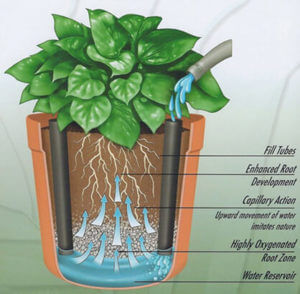What are the best irrigation methods for interior plants?
Mastering irrigation for building interiors
Interior landscapes require a customized approach when it comes to irrigation. One that will keep plants healthy and be thriving indoors.
At Planterra, our experts use the most effective technology and methods of maintaining plantscapes indoors. When we ensure more efficient water usage, those practices can help control labor costs, too. Wondering how it works?

Start with self-watering planters
It all begins with self-watering planters. We recommend a sub-irrigation system for indoor plantscaping.
Since the majority of interior plant installations are containerized, sub-irrigation is a reliable standard for indoor plants. It features an internal reservoir that allows plant roots to absorb air and water as needed. This ensures that plants are never overwatered or undernourished.
How does sub-irrigation work?
 According to Natalie Rector at Michigan State University Extension: “This system is managed to maintain a consistent water level below the roots and depends on capillary movement upward, providing a constant and readily available water supply to the plants.”
According to Natalie Rector at Michigan State University Extension: “This system is managed to maintain a consistent water level below the roots and depends on capillary movement upward, providing a constant and readily available water supply to the plants.”
We use a capillary system that is water-wicking.
The material used has the ability to absorb water from the reservoir and transfers it to the roots of the plant whenever it requires moisture.
Indoor plants using a sub-irrigation system also rely on soil-less growing media – a safe alternative to other kinds of growing media. The soil or material used to grow the plant does not contain organic compounds. It is sterilized, so it will not rot or produce mold. This is considered a health standard for indoor environments.
What are the benefits of sub-irrigation?
Sub-irrigation is a preferred method of watering indoor plants for many reasons:
- Plants drink water as it is needed, and therefore are less susceptible to over- or under-watering.
• The plant is contained and is less susceptible to pests.
• Sub-Irrigation requires less water than traditional systems.
• It limits the exposure of moist growing media to air contact.
Monitoring and Maintenance
Sub-irrigation provides consistency. It is not a fully automated system of irrigation. It still needs to be monitored. Water levels and soil should be checked regularly.
Automated systems are rarely used or recommended indoors. They can be found in some in-ground atriums or built-in living walls. But over time parts of an automated system can break down and cause a risk for water damage.
At Planterra, our horticultural technicians routinely check sub-irrigation reservoirs, just as they monitor, clean, groom and shine plants. This is all completed during regular site visits.
Are you considering irrigation options for an indoor plantscape? Can we advise on how sub-irrigation and a capillary water-wicking system will help maintain indoor plants? We have experts available to help. Contact us at Planterra.com for more information.
Speak with a Planterra expert today.
